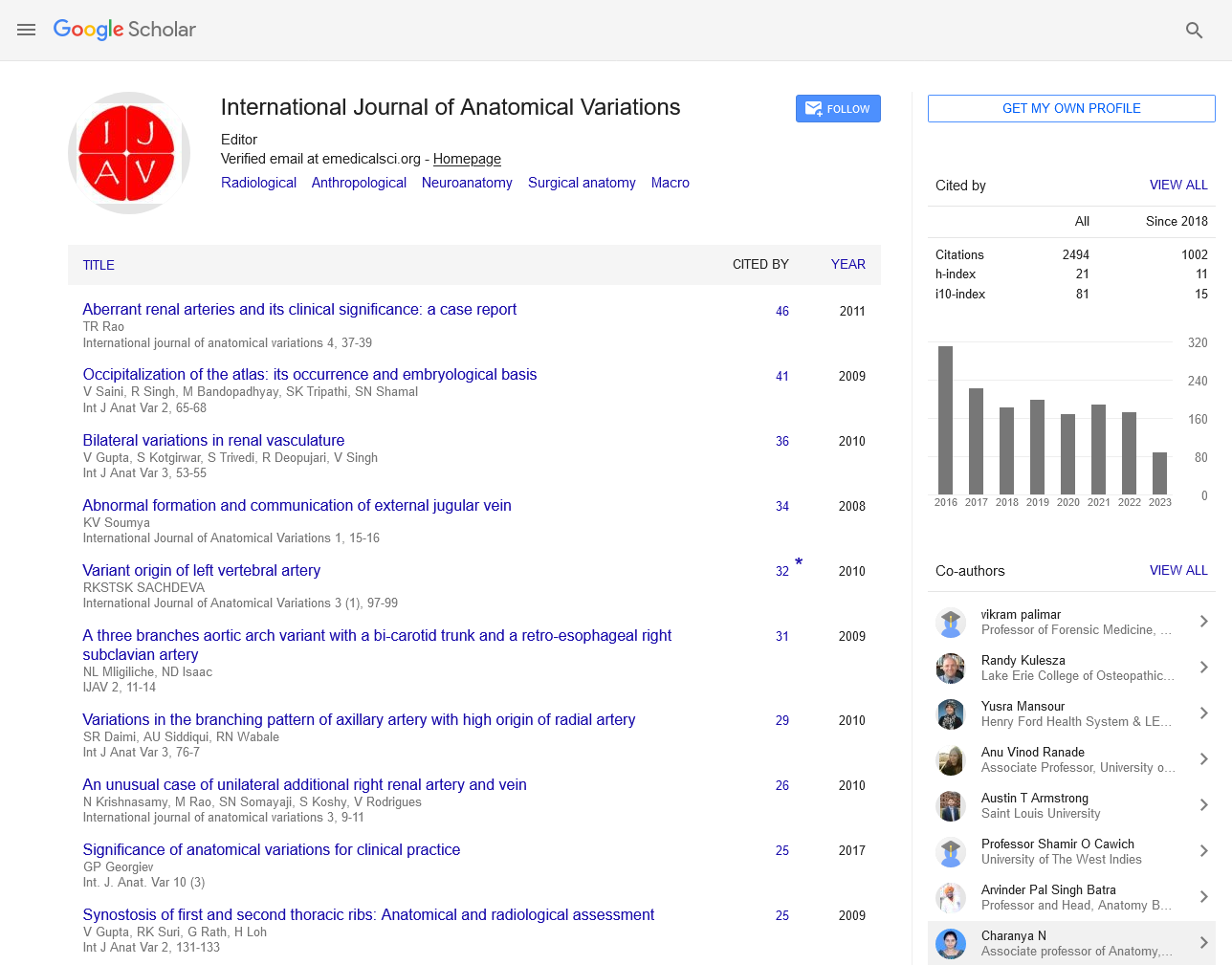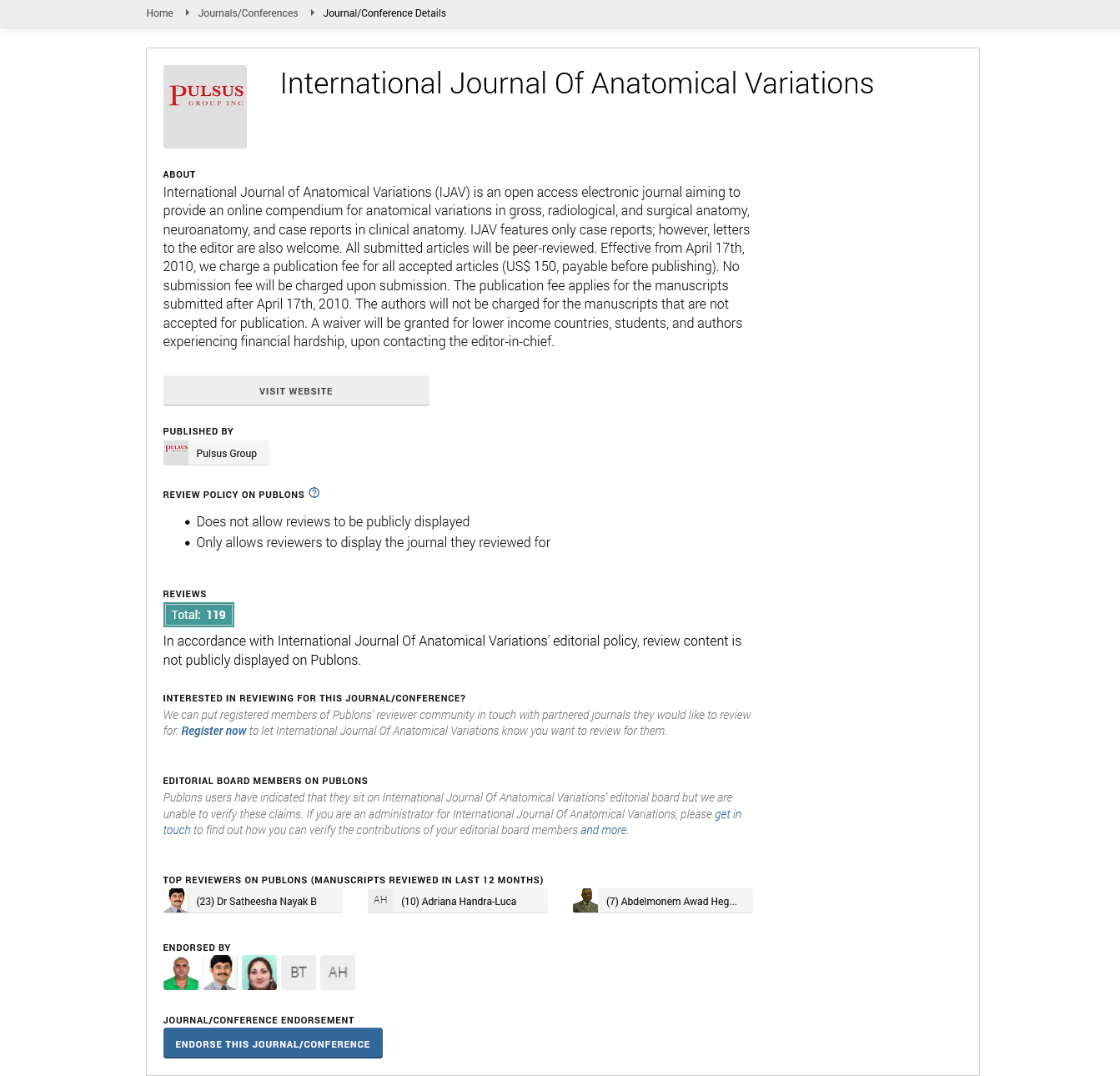Anatomical Terminology a Comprehensive Review of Nomenclature and Its Importance in Medical Science
Received: 01-Mar-2025, Manuscript No. ijav-25-7639; Editor assigned: 04-Mar-2025, Pre QC No. ijav-25-7639 (PQ); Reviewed: 19-Mar-2025 QC No. ijav-25-7639; Revised: 26-Mar-2025, Manuscript No. ijav-25-7639 (R); Published: 30-Mar-2025, DOI: 10.37532/1308 4038.18(3).497
Citation: Hendry J. Anatomical Terminology a Comprehensive Review of Nomenclature and Its Importance in Medical Science. Int J Anat Var. 2025; 18(3): 764-764.
This open-access article is distributed under the terms of the Creative Commons Attribution Non-Commercial License (CC BY-NC) (http://creativecommons.org/licenses/by-nc/4.0/), which permits reuse, distribution and reproduction of the article, provided that the original work is properly cited and the reuse is restricted to noncommercial purposes. For commercial reuse, contact reprints@pulsus.com
Abstract
Anatomical terminology forms the foundational language of medical and health sciences. It facilitates precise communication among professionals across disciplines and regions. This paper explores the historical development, systematic structure, and clinical importance of anatomical terminology. Further, it examines contemporary challenges and future directions in the standardization and global adoption of anatomical nomenclature. By elucidating the principles and usage of anatomical terms, this review highlights the role of anatomical language in improving medical education, diagnostics, and Interprofessional collaboration.
INTRODUCTION
Anatomy, the study of body structure, is an essential discipline in medicine, biology, and related sciences. Its language—anatomical terminology—is crucial for accurate description, diagnosis, and education [1]. Standardized anatomical terms allow health professionals from different linguistic and cultural backgrounds to communicate effectively and avoid errors that may arise from ambiguity or colloquial usage. This paper delves into the origins, structure, applications, and ongoing evolution of anatomical terminology [2].
HISTORICAL BACKGROUND
The roots of anatomical terminology trace back to ancient civilizations, particularly Greece and Rome. Early anatomists such as Hippocrates, Galen, and later Vesalius, laid the groundwork for modern anatomical understanding. However, inconsistent and overlapping terms proliferated for centuries. In response, the Basel Nomina Anatomica (BNA) was introduced in 1895 to establish a uniform set of terms. It was succeeded by the Nomina Anatomica (NA) and later by Terminologia Anatomica (TA), developed under the auspices of the Federative Committee on Anatomical Terminology (FCAT) and the International Federation of Associations of Anatomists (IFAA). The TA remains the current global standard for anatomical nomenclature [3].
PRINCIPLES OF ANATOMICAL TERMINOLOGY
Anatomical terms are derived primarily from Latin and Greek, structured to describe location, relation, shape, function, and number [4].
Clinical and Educational Relevance
Teaching anatomy with precise vocabulary ensures comprehension and consistency in instruction worldwide. Surgeons rely on exact terminology to describe procedural steps, navigate anatomical spaces, and avoid iatrogenic injuries. Radiologists interpret scans based on standard anatomical planes and regions, facilitating correct diagnosis. Scientific papers use accepted anatomical terms to maintain global readability and reproducibility [5].
CHALLENGES IN ANATOMICAL NOMENCLATURE
Latin and Greek roots can pose difficulties for non-native speakers or students unfamiliar with classical languages. Terms based on individuals' names (e.g., Fallopian tubes) often lack descriptive value and vary across regions. New imaging techniques and discoveries necessitate continual updates to anatomical nomenclature. Anatomy overlaps with embryology, histology, and physiology, requiring harmonization across specialties. Efforts are ongoing to resolve these issues, promoting a more universally accessible and intuitive terminology.
FUTURE DIRECTIONS
Interactive atlases, 3D modeling, and virtual dissection tools are being increasingly integrated into medical curricula. Organizations like the IFAA and WHO are working to refine and disseminate updated terminologies. Moving away from eponyms and towards more descriptive and gender-neutral language enhances clarity and inclusivity. Incorporating consistent terminology into related disciplines will improve interdisciplinary communication.
CONCLUSION
Anatomical terminology is not merely a lexicon but the backbone of effective medical communication. It bridges gaps between disciplines, cultures, and generations of practitioners. Continued refinement and global standardization will ensure that anatomical language remains relevant, accessible, and beneficial to the advancement of medical science.
REFERENCES
- Fontana F, Coppola A, Ferrario L. Internal Iliac Artery Embolization within EVAR Procedure: Safety, Feasibility, and Outcome. J Clin Med. 2022; 11(24):73-99.
- Park K-M, Yang S-S, Kim Y-W, Park KB, Park HS, et al. Clinical outcomes after internal iliac artery embolization prior to endovascular aortic aneurysm repair. Surg Today 2014; 44:472-477.
- Rayt HS, Bown MJ, Lambert KV. Buttock claudication and erectile dysfunction after internal iliac artery embolization in patients prior to endovascular aortic aneurysm repair. Cardiovasc Intervent Radiol. 2008; 31(4):728-34.
- Patel SD, Perera A, Law N, Mandumula S. A novel approach to the management of a ruptured Type II endoleak following endovascular repair of an internal iliac artery aneurysm. Br J Radiol. 2011; 84(1008):e240-2.
- Szymczak M, Krupa P, Oszkinis G, Majchrzycki M. Gait pattern in patients with peripheral artery disease. BMC Geriatrics. 2018; 18:52.
Indexed at, Google Scholar, Crossref
Indexed at, Google Scholar, Crossref
Indexed at, Google Scholar, Crossref
Indexed at, Google Scholar, Crossref






